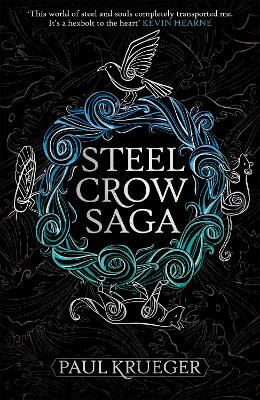Reviewed by Amber (The Literary Phoenix) on
To steal a phrasing from one of the characters, it was a long walk to a very anime battle scene.
The way this book is written falls into very detailed descriptions. There’s not a lot of room for the reader’s imagination in way characters think, feel, or how the world works. Steel Crow Saga is written from four perspectives and by the time you reach the end of the book, you know pretty well how each of them thinks, multiple stories from their past, how they feel about their families, and their personal moral compasses. Regardless of how each flashback relates (or doesn’t) to the story… it’s all there. The wordiness in the writing style doubled with all this fleshing out made this a bit of a boring read for me.
Behind the author’s particular style, there’s a uniqueness to this book. Steel Crow Saga definitely draws inspiration from anime, and that’s something you don’t see in your casual epic fantasy. The way character should-bind to their familiars (called “shades”) feels very similar to the anime fantasy relationship between heroes and their swords. The relationship between human and shade reminds me of a watered down, more mutually beneficial version of Naruto’s relationship with the nine-tailed fox demon trapped inside him.
Like I said, very anime.
And for that, I have to apologize, because anime really isn’t my thing. It’s my husband’s thing and my familiarity of it is limited to the bits and pieces of what I’ve seen of his playlists. Maybe Naruto isn’t the best choice, but that’s what I’ve got in my repertoire. As I said, it’s a style I haven’t seen before in this format and I respect that uniqueness, but I also have to acknowledge that for all the sappiness and drama and grand gestures, it’s not the style I personally prefer.
The plot itself took the scenic route, with a lot of partner-swapping and sidetracked conversations to give a better idea of the political climate and the various character backgrounds. This may all play into the series plot, but there was some much time between plot sequences that I honestly forgot what the point of the whole thing was about halfway through. Then, fortunately, the villain made a quick appearance somewhere in the 300s and reminded me.
In as far as the characters go, they were all developed and interesting enough in their own accord, but now that I’ve finished, I don’t think I was able to connect with them closely enough that they’ll stay with me now that I’ve finished. I never felt an emotional connection to the characters, who spent a lot of time in discussion and and flat inner monologues. Even the relationship between Lee and Xiulan felt forced and awkward.
The character I liked best was Tala. Even though she was a sergeant, Tala had the most emotion and it was easiest to care about what her character thought and felt. Her actions didn’t always make sense, but she was the driving force that pushed me through some of the rougher bits; this is the advantage to a book with multiple POVs.
There was one scene with Xiulan that stood out to me. It’s made abundantly clear throughout the book that Xiulan had some horrible, traumatic experience with mushrooms (explained near the end). At one point, Xiulan finds herself in a refrigerator essentially being mocked by a box of mushrooms and I’m not sure quite why, but the scene was a bit hilarious. The writing was on point there and I really liked that scene. I don’t want to say more about it and risk spoilers, but look out for the box of MUSHROOMS, y’all.
I think this book would be more memorable to me, personally, if it had been trimmed down by at least 150 pages and condensed more effectively. However, as it stands, I think there will be an audience for this kind of writing. I’ve heard a few people excited for Steel Crow Saga, and I hope these people love it! Unfortunately, it just wasn’t a fit for me and I won’t be continuing the series.
Reading updates
- Started reading
- 22 June, 2019: Finished reading
- 22 June, 2019: Reviewed
